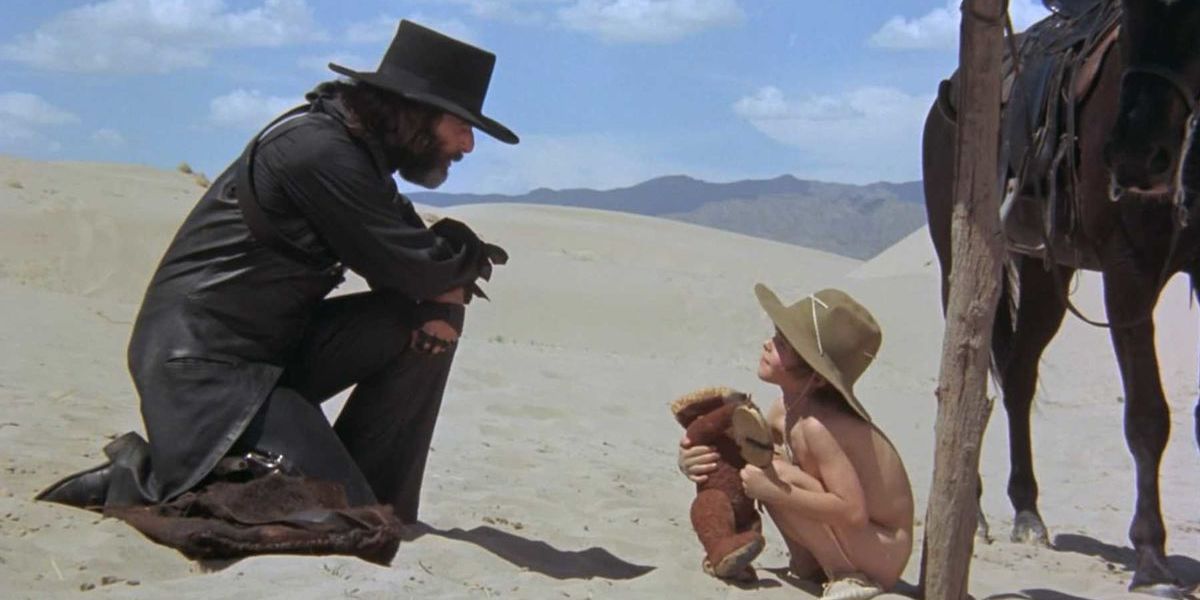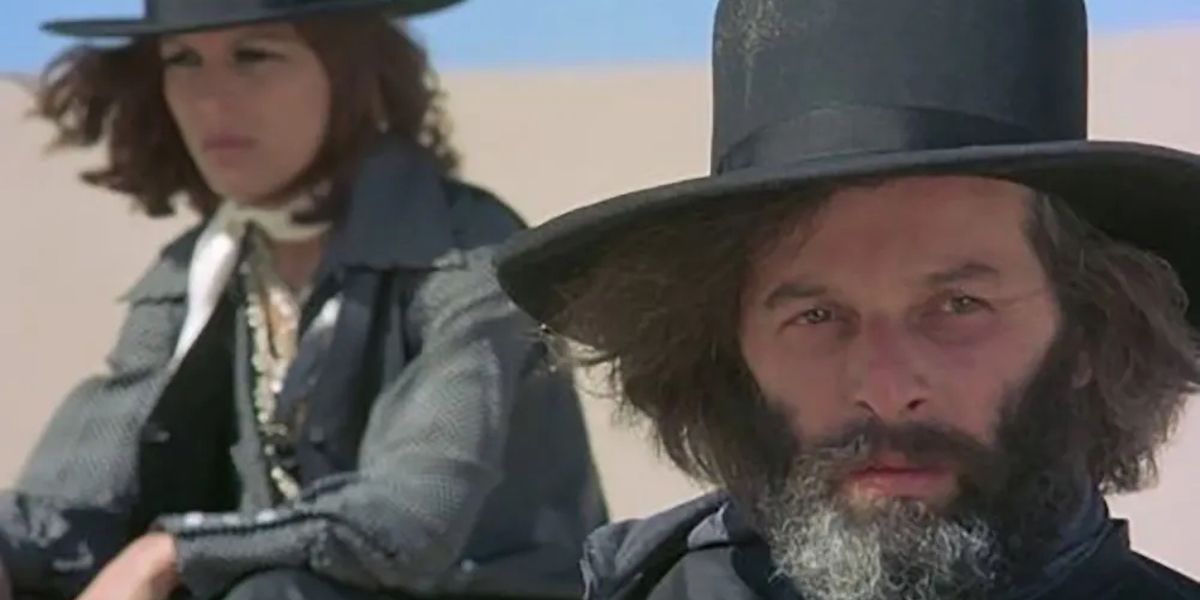[ad_1]
Trigger Warning: The following references disturbing sexual assault.
After The Beatles split up in 1970, they each continued to produce their own music independently, as well as endorse the work of other fresh creatives. The Beatles’ Apple Corps label continued to support up-and-coming performers such as Badfinger, and their creative championing also extended to the world of film. Most famously, George Harrison took out a mortgage on his home to help finance the Monty Python movie The Life of Brian, with Harrison claiming the filmmakers embodied in the ’70s what the Beatles had in the ’60s. Lesser known, however, is John Lennon‘s involvement in endorsing Alejandro Jodorowsky‘s Acid Western film El Topo, a horrifying feature, particularly given the extremely problematic nature of circumstances surrounding the film’s production.
The 1970 Mexican film, which translates as “The Mole,” opens with its titular character (played by writer-director Jodorowsky himself) riding on horseback with his naked cherub-like son (played by his real-life son Brontis Jodorowsky). After coming across the remains of a massacred town, El Topo tracks down the perpetrators and kills them, inviting their captive woman Marah (Mara Lorenzio) to join him, leaving his son Hijo with the monks he liberated. Later, El Topo seemingly rapes Marah, strangely changing her attitude towards El Topo to a more liberated and adventurous one. Marah says she refuses to love El Topo fully until he proves himself as the best, by finding and defeating the four famous fighting masters of the desert. This task, however, is only introduced over 30 minutes into the film and ends two-thirds of the way through the film. From there, a betrayed El Topo embarks on a different mission to help disabled cave-dwellers escape their doom. And that’s just the tip of El Topo‘s absurdity iceberg!
What Is ‘El Topo’ Really About?
During his mission to defeat the four masters of the desert, the character’s doubt about his task grows. Each master represents a different Judeo-Christian practice or Eastern philosophy, and although they outsmart and overpower him, he defeats each one with nothing more than tricks and luck. It is only once Marah and another woman become lovers that El Topo is forced to accept that he has been betrayed, and is later enlightened by a group of underground cave-dwellers unable to escape due to their disabilities. This underground setting is not where El Topo (or The Mole) gets his name, however, as the film’s opening explains; “The Mole digs tunnels under the earth, looking for the sun. Sometimes he gets to the surface. When he sees the sun, he is blinded.” Although this imagery is referenced at the film’s climax when El Topo breaks through the tunnel wall, it also lends itself to a metaphorical reading. It is perhaps a reference to the Bible’s Paul-becoming-Saul story which would explain the story’s chapter titles (Genesis, Prophets, Psalms, etc.). Ultimately, the film’s absurd style insists on being experienced and not explained, leaving its true meaning in the hands of each individual viewer.
El Topo was released in 1970, at a time when Spaghetti Westerns had long hijacked the Western genre. Spaghetti Westerns were more artistic and gritty representations of the stories of the American frontier than the ones told by Hollywood and were predominantly shot for cheap on location in Italy. Although this is where the subgenre got its name, it developed a visual, aural, and performative style so specific that other countries and cultures soon became known for their own takes on the Spaghetti Western genre too. One of these “sub-sub genres” is the “Acid Western,” which blends the religious metaphor of the original Hollywood westerns with the modern style of the Spaghetti Western. El Topo is said by the BBC to have been the original Acid Western.
‘El Topo’ Was Always Intended for American Audiences
Alejandro Jodorowsky is a Chilean-French avant-garde filmmaker born to Ukranian-Jewish parents in Chile. His first film, Fando y Lis, follows post-apocalyptic survivor Fando (Sergio Klainer) and his paraplegic girlfriend Lis (Diana Mariscal) as they travel across a wasteland to find the mythical city of Tar and achieve enlightenment. The film premiered in 1968 at the Acapulco Film Festival where its controversial content incited a riot, causing Mexico to ban the film. It would not be released there again until 1972, one year after it had been re-dubbed and edited. When Jodorowsky shot El Topo in Mexico, it was never intended for Mexican audiences, instead focusing on the modern art scene of New York City. There, Elgin Theater owner Ben Barenholtz attempted and failed to purchase the American rights after becoming fascinated by the film, even in spite of several audience members walking out. Barenholtz did, however, manage to convince its producer to show the film at his theater.
As a lover of New York’s avant-garde art scene, John Lennon was among the audience one night and found El Topo deliciously surreal. Jodorowsky later recalled, “When I brought El Topo to New York, no one understood the picture. But John Lennon understood. John and Yoko Ono, they presented El Topo in the United States; they introduced it.” Lennon urged Beatles manager Allen Klein to invest in Jodorowsky’s future productions and soon after, Klein’s company ABKCO Films became El Topo‘s United States distributor, getting the film seen across the country. At Lennon’s request, composer John Barham even re-recorded the score at Abbey Road Studios to be released on Apple Records. Thanks in no small part to John Lennon, El Topo became an underground sensation and helped made Jodorowsky a renowned artist and filmmaker. But that didn’t come without its controversies.
How Did John Lennon’s Influence Lead to Alejandro Jodorowsky’s Rise & Fall?
While trying to promote his shocking film, Alejandro Jodorowsky attempted to shock the press by stating, “I had put a clause in all the women’s contracts stating that they would not make love with the director.” This was quoted in the 1972 book El Topo: A Book of the Film by Jodorowsky himself. “We went to the desert with two other people: the photographer and a technician. No one else. I said, ‘I’m not going to rehearse. There will be only one take because it will be impossible to repeat. […] I really raped her. And she screamed.” Later, amidst the #MeToo movement, Jodorowsky claimed to have fabricated this story for its shock value, expressing regret when confronted with his words. “I acknowledge that this statement is problematic in that it presents fictional violence against a woman as a tool for exposure, and now, fifty years later, I regret that this is being read as truth. My practice is centered on healing and love. I invite further dialogue in the spirit of progress.”
After El Topo, Jodorowsky used Allen Klein’s investment to make 1973’s The Holy Mountain, the lead role of which was originally offered to George Harrison. Jodorowsky claims Harrison refused due to a scene in which he would have needed to bare his anus on camera beside a live hippopotamus. Klein instructed Jodorowsky to make his next film an adaptation of the French BDSM novel The Story Of O, but when, as the BBC reported, Jodorowsky refused due to the material’s sexism, Klein removed Jodorowsky’s existing films from his company’s distribution slate for over thirty years. Ultimately, Lennon’s work in bringing Klein and Jodorowsky together would account for both the rise and fall of the auteur director.
Despite his unorthodox filmmaking style, it’s interesting to note how obscure a figure Jodorowsky has become over the years. His work has inspired some of the world’s most renowned art film directors including David Lynch and Nicolas Winding Refn, with El Topo specifically cited as an inspiration for Gore Verbinski‘s Rango. Reportedly, Rango‘s Johnny Depp was attached to star alongside Marilyn Manson in a sequel to El Topo called Abelcain or The Sons of El Topo, but Jodorowsky struggled to raise the funds. The sequel eventually became a graphic novel. Somewhat tragically, Jodorowsky’s most famous film today is arguably a documentary about his version of a Dune adaptation that he never got to make. Instead, Jodorowsky fan David Lynch was hired to adapt Frank Herbert‘s space-epic novel. Jodorowsky’s Dune is a showcase of how a filmmaker’s countless hours of work and dedication can fall by the wayside without the proper support, emphasizing how Lennon’s endorsement of El Topo was all the more paramount in getting Jodorowsky’s work seen.
[ad_2]
Source link
Armessa Movie News


